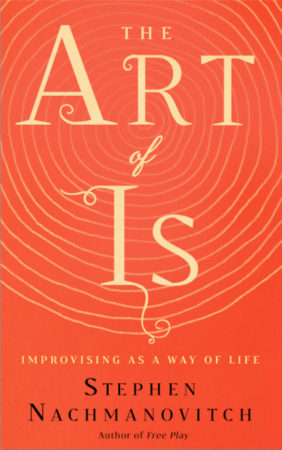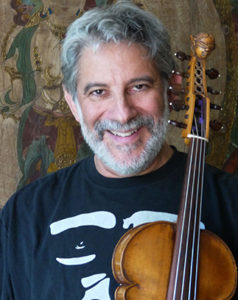
The Art of IS – Improvising as a Way of Life
Imagine a white canvas in front of you – and a vision in your mind of blues and greens and purples. So you begin to paint, carefully placing your brush on the canvas as you blend the colors – and suddenly, you knock a jar of brown paint onto your palette. What then?
Do you clean it up? Do you start again?
Or do you wonder what the synchronicity of the spillage might be telling you? What wants to be noticed? What wants to be included?
When we allow ourselves to get attached to a specific outcome, we can rob ourselves of an opportunity to engage in miraculous creation – the kind that comes from creative surrender.
What happens when we let go – and just BE with our creative intentions without trying to control the outcome?
This is where improvisation comes into play. What do you do in the moment – with what you have?
To help answer this question, I’ve invited author Stephen Nachmanovitch to join me on my blog today to share his thoughts about “The Art of IS: Improvising as a Way of Life” – which happens to be the title of his new book, recently published by New World Library.
******************
Can you tell us what you mean by “The Art of IS?”
Well, we IS here – and we IS talking to each other right now. The fundamental condition of improvisation is conversation. You may do it with musical instruments, you may do it with beautiful artistic techniques – but the conversation is the template for improvising. What’s interesting is this paradox with the most direct connection to what’s in front of you. You often get the most interesting, the most fanciful, the most imaginative responses when you’re not trying to entertain or perform – it’s more interesting. It just is – without a lot of preparation, if any.
In your book, you mention that the most ordinary act of creativity is spontaneous conversation — the art of listening and responding. Could you give us an example?
Did you know that the rousing ending of Dr. Martin Luther King’s infamous “I Have a Dream” speech was improvised? When King paused to look at his notes, the gospel singer Mahalia Jackson shouted “tell ’em about the dream!” At this point, according to Dr. King’s speechwriter Clarence B. Jones he, pushed “the text of his prepared remarks to one side of the lectern. He shifted gears in a heartbeat, abandoning whatever final version he’d prepared… he’d given himself over to the spirit of the moment.”
What if you could truly give yourself over to the spirit of the moment in your everyday life? What incredible things could you achieve?
You also note that improv thrives on our mistakes and how we integrate them into the flow of our lives. Could you elaborate on this?
From Martin Luther King’s improvised speech about his dream, to the story of a medieval Japanese woman who fends off an attacker with a paper sword, the theme that unites the stories in this book is doing what we can with what we have — whether we have a microphone and an enraptured audience, or a sword in our face and nothing but a blank sheet of paper in our hand. Improvising is not a special act of genius of which few are capable but is in fact the natural activity of all humans, whether we’re driving a car or holding a conversation. People who might claim they could never improvise negotiate these tasks with fluidity and ease every day. Art and the art-making process can influence our relationship with ourselves, with those around us, and by extension with society as a whole.
******************
 Dr. Stephen Nachmanovitch is the author of The Art of Is and Free Play. He performs and teaches internationally as an improvisational violinist, lecturer, workshop leader, and multimedia artist. He holds degrees from Harvard and the University of California. His work spans many fields, exploring the spiritual and social underpinnings of art. He lives with his family in Charlottesville, Virginia. Find out more about his work at www.freeplay.com.
Dr. Stephen Nachmanovitch is the author of The Art of Is and Free Play. He performs and teaches internationally as an improvisational violinist, lecturer, workshop leader, and multimedia artist. He holds degrees from Harvard and the University of California. His work spans many fields, exploring the spiritual and social underpinnings of art. He lives with his family in Charlottesville, Virginia. Find out more about his work at www.freeplay.com.


One Comment
Tracy Thaden
What a beautiful message! Thank you for sharing from Dr. Stephen Nachmanovitch too! Thanks for reminding us of the importance of allowing something to happen rather than controlling the situation at all times!